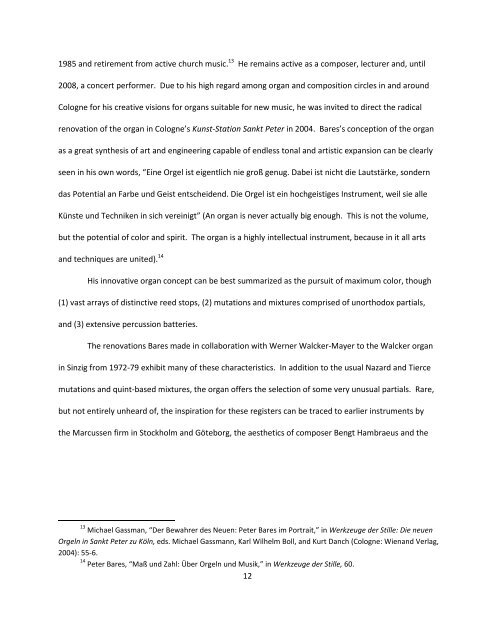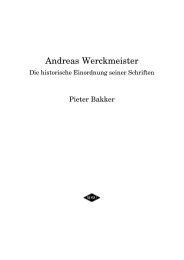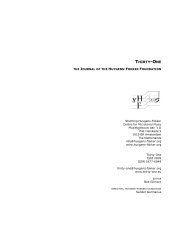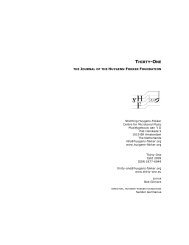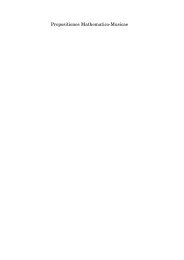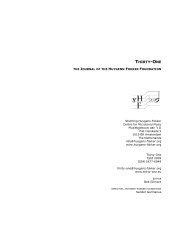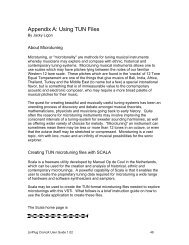Recent Organ Design Innovations and the 21st-century - Stichting ...
Recent Organ Design Innovations and the 21st-century - Stichting ...
Recent Organ Design Innovations and the 21st-century - Stichting ...
Create successful ePaper yourself
Turn your PDF publications into a flip-book with our unique Google optimized e-Paper software.
1985 <strong>and</strong> retirement from active church music. 13 He remains active as a composer, lecturer <strong>and</strong>, until<br />
2008, a concert performer. Due to his high regard among organ <strong>and</strong> composition circles in <strong>and</strong> around<br />
Cologne for his creative visions for organs suitable for new music, he was invited to direct <strong>the</strong> radical<br />
renovation of <strong>the</strong> organ in Cologne’s Kunst-Station Sankt Peter in 2004. Bares’s conception of <strong>the</strong> organ<br />
as a great syn<strong>the</strong>sis of art <strong>and</strong> engineering capable of endless tonal <strong>and</strong> artistic expansion can be clearly<br />
seen in his own words, “Eine Orgel ist eigentlich nie groß genug. Dabei ist nicht die Lautstärke, sondern<br />
das Potential an Farbe und Geist entscheidend. Die Orgel ist ein hochgeistiges Instrument, weil sie alle<br />
Künste und Techniken in sich vereinigt” (An organ is never actually big enough. This is not <strong>the</strong> volume,<br />
but <strong>the</strong> potential of color <strong>and</strong> spirit. The organ is a highly intellectual instrument, because in it all arts<br />
<strong>and</strong> techniques are united). 14<br />
His innovative organ concept can be best summarized as <strong>the</strong> pursuit of maximum color, though<br />
(1) vast arrays of distinctive reed stops, (2) mutations <strong>and</strong> mixtures comprised of unorthodox partials,<br />
<strong>and</strong> (3) extensive percussion batteries.<br />
The renovations Bares made in collaboration with Werner Walcker-Mayer to <strong>the</strong> Walcker organ<br />
in Sinzig from 1972-79 exhibit many of <strong>the</strong>se characteristics. In addition to <strong>the</strong> usual Nazard <strong>and</strong> Tierce<br />
mutations <strong>and</strong> quint-based mixtures, <strong>the</strong> organ offers <strong>the</strong> selection of some very unusual partials. Rare,<br />
but not entirely unheard of, <strong>the</strong> inspiration for <strong>the</strong>se registers can be traced to earlier instruments by<br />
<strong>the</strong> Marcussen firm in Stockholm <strong>and</strong> Göteborg, <strong>the</strong> aes<strong>the</strong>tics of composer Bengt Hambraeus <strong>and</strong> <strong>the</strong><br />
13 Michael Gassman, “Der Bewahrer des Neuen: Peter Bares im Portrait,” in Werkzeuge der Stille: Die neuen<br />
Orgeln in Sankt Peter zu Köln, eds. Michael Gassmann, Karl Wilhelm Boll, <strong>and</strong> Kurt Danch (Cologne: Wien<strong>and</strong> Verlag,<br />
2004): 55-6.<br />
14 Peter Bares, “Maß und Zahl: Über Orgeln und Musik,” in Werkzeuge der Stille, 60.<br />
12


